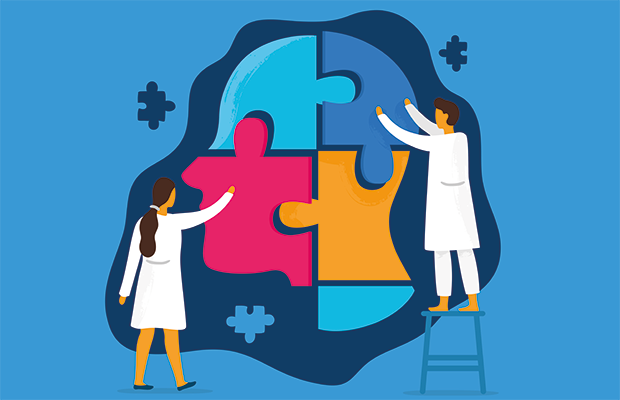SLT basically see’s behaviour as a result of learning through observation, imitation and modelling and that all learning takes place in a social context (rather than it being a biological, innate drive). It’s described through the stages of attention, retention, imitation and eventually modelling, which is when the desired behaviour is carried out. So for example Bandura’s BoBo doll study supports SLT as it showed that the children who were exposed to violent behaviour were more likely to imitate and act aggressively. Hope this helps 

Bandura is the father of Social Learning Theory, he is the researcher who came up with it and conducted the Bobo doll study. Putting it simply, Bandura's SLT explained observational learning, which means people learn from observing the environment around them (vicarious reinforcement). For example a girl may learn to wear makeup through watching her mother using it. This is important, as it differs from traditional Learning Theory, which proposed animals learn through interaction with their environment (direct reinforcement). Other areas of AO1 include the factors identified by Bandura which influences this learning process. Overall it is a solid way of explaining human behaviour with a lot of merits, as Bandura took into account both the influence of the environment on an individual and the individual factors which affect the likelihood of learning.
Giving a broader example, an individual may watch a group of criminals rob a bank, leave with lots of money and not get caught. Using social learning theory, the observation of this behaviour along with the positive consequences of robbing the bank (getting rich) and lack of negative consequences (no punishment) would thus be learnt by the observer. However, this does not necessarily mean the individual would become a criminal, as other factors affect this - called meditational processes. All of us may know how to rob a bank (from films, social media etc) but we don't.
Giving a broader example, an individual may watch a group of criminals rob a bank, leave with lots of money and not get caught. Using social learning theory, the observation of this behaviour along with the positive consequences of robbing the bank (getting rich) and lack of negative consequences (no punishment) would thus be learnt by the observer. However, this does not necessarily mean the individual would become a criminal, as other factors affect this - called meditational processes. All of us may know how to rob a bank (from films, social media etc) but we don't.
(edited 6 years ago)
Original post by isla.verney
SLT basically see’s behaviour as a result of learning through observation, imitation and modelling and that all learning takes place in a social context (rather than it being a biological, innate drive). It’s described through the stages of attention, retention, imitation and eventually modelling, which is when the desired behaviour is carried out. So for example Bandura’s BoBo doll study supports SLT as it showed that the children who were exposed to violent behaviour were more likely to imitate and act aggressively. Hope this helps 

Thankyou this helps so much!
So bandura supports the SLT, so the SLT is just a theory for different ways we before such as identification, imitation, reinforcement and modelling
Original post by Harman17
Thankyou this helps so much!
So bandura supports the SLT, so the SLT is just a theory for different ways we before such as identification, imitation, reinforcement and modelling
So bandura supports the SLT, so the SLT is just a theory for different ways we before such as identification, imitation, reinforcement and modelling
Behave*
Original post by Harman17
Thankyou this helps so much!
So bandura supports the SLT, so the SLT is just a theory for different ways we before such as identification, imitation, reinforcement and modelling
So bandura supports the SLT, so the SLT is just a theory for different ways we before such as identification, imitation, reinforcement and modelling
Yep! So we identify with a role model and through vicarious reinforcement, imitation, and modelling we learn that behaviour and carry it out
Original post by isla.verney
Yep! So we identify with a role model and through vicarious reinforcement, imitation, and modelling we learn that behaviour and carry it out
Thankyou!

Any good with explaining biopsychology because I don’t understand that at all!
Social Learning Theory is basically learning through watching others, for example, Vicarious Reinforcement which is when you learn that if others do good things, you will get rewarded for doing good things and vise vera. Bandura's BoBo doll study basically shows that the children who watched the violent behavior then learned it and are then more likely to be aggressive towards others as they have witnessed it from adults.
Original post by Harman17
Thankyou! 
Any good with explaining biopsychology because I don’t understand that at all!

Any good with explaining biopsychology because I don’t understand that at all!
I mean ... 😂 Which part?
Original post by isla.verney
I mean ... 😂 Which part?
Honestly all of it 😂
Original post by LukeGreatorex
Bandura is the father of Social Learning Theory, he is the researcher who came up with it and conducted the Bobo doll study. Putting it simply, Bandura's SLT explained observational learning, which means people learn from observing the environment around them (vicarious reinforcement). For example a girl may learn to wear makeup through watching her mother using it. This is important, as it differs from traditional Learning Theory, which proposed animals learn through interaction with their environment (direct reinforcement). Other areas of AO1 include the factors identified by Bandura which influences this learning process. Overall it is a solid way of explaining human behaviour with a lot of merits, as Bandura took into account both the influence of the environment on an individual and the individual factors which affect the likelihood of learning.
Giving a broader example, an individual may watch a group of criminals rob a bank, leave with lots of money and not get caught. Using social learning theory, the observation of this behaviour along with the positive consequences of robbing the bank (getting rich) and lack of negative consequences (no punishment) would thus be learnt by the observer. However, this does not necessarily mean the individual would become a criminal, as other factors affect this - called meditational processes. All of us may know how to rob a bank (from films, social media etc) but we don't.
Giving a broader example, an individual may watch a group of criminals rob a bank, leave with lots of money and not get caught. Using social learning theory, the observation of this behaviour along with the positive consequences of robbing the bank (getting rich) and lack of negative consequences (no punishment) would thus be learnt by the observer. However, this does not necessarily mean the individual would become a criminal, as other factors affect this - called meditational processes. All of us may know how to rob a bank (from films, social media etc) but we don't.
Thankyou! This helps

Original post by Harman17
Honestly all of it 😂
Okay 😂 In a nutshell it’s the branch of psychology that looks at the brain, neurotransmitters and human biology and how this effects our behaviour.
There’s to “systems” which are the Nervous System and the Endocrine System. The NS looks at the role of nerves and how they convert information that influences behaviour however the ES focuses on the role of hormones and chemical communications and how they affect behaviour. An example of when both of these branches are used is in the Fight or Flight response.
You’ve then got Action Potentials which is when neutrons send messages electrochemically. When a stressor is perceived, an action potential is generated, sending a chemical message along the neutron. In further depth you can look at the stages of AP and the role of sodium, depolarisation, potassium and hyperpolarisation. Myelination is also important in AP; a fatty layer accumulated around axons on the neutrons, thus enabling nerve cells to transmit information faster.
Lastly there’s synaptic transmission. An action potential will arrive at the presynaptjc membrane, stimulating vesicles to move towards the edge of the membrane. Vesicles will then release neurotransmitters into the synaptic cleft (the gap). The neurotransmitters will bind the the dendrites/receptors on the post synaptic membrane causing either an inhibitory or exhibitors effect in the post synaptic neutron.
(Hope that kinda makes sense? Sorry for the word blurt 😂)
(edited 6 years ago)
Quick Reply
Related discussions
- A-level Exam Discussions 2024
- Psychology at Leicester
- Can I do masters in clinic/child psychology
- criminal psychology or pyschology degree?
- psychology
- Psychology doctorate
- A-levels choice
- Oxford PPL vs Cambridge PBS?
- Is a psychology degree hard without a science background?
- A level sociology or english lit?
- Psychology degree
- neuroscience vs psychology
- A-Level Choices
- Psychology application
- Changing uni course
- Swansea University enquiry
- Psychology Personal statement Help
- Is studying Psychology worth it?
- psychology: personal statement
- MSc Psychological Science academic standing
Latest
Trending
Last reply 33 minutes ago
OCR A-LEVEL PSYCHOLOGY PAPER 3 (H567/03) - 3rd June [Exam Chat]Last reply 6 days ago
OCR A-LEVEL PSYCHOLOGY PAPER 2 (H567/02) - 22nd May [Exam Chat]Last reply 2 weeks ago
AQA A Level Psychology Paper 3 (7182/3) - 3rd June 2024 [Exam Chat]Last reply 2 weeks ago
AQA A Level Psychology Paper 1 (7182/1) - 17th May 2024 [Exam Chat]Last reply 2 weeks ago
EDEXCEL A-LEVEL PSYCHOLOGY (9PS 01) - 17th May [Exam Chat]Last reply 2 weeks ago
AQA A Level Psychology Paper 2 (7182/2) - 22nd May 2024 [Exam Chat]Last reply 3 weeks ago
Edexcel GCSE Psychology Papers 1 & 2 - 19th & 26th May 2023 [Exam Chat]Last reply 1 month ago
AQA A-level Psychology Paper 2 (7182/2) - 25th May 2023 [Exam Chat]Last reply 1 month ago
Edexcel A-level Psychology Paper 1 (9PS0 01) - 19th May 2023 [Exam Chat]Last reply 1 month ago
What is your Method to remembering AO3 Evaluation Points in Psychology?Posted 1 month ago
Marking AQA a-level Psychology Essay: Evaluate and outline the social learning theoryLast reply 2 months ago
AQA A-level Psychology Paper 3 (7182/3) - 5th June 2023 [Exam Chat]Trending
Last reply 33 minutes ago
OCR A-LEVEL PSYCHOLOGY PAPER 3 (H567/03) - 3rd June [Exam Chat]Last reply 6 days ago
OCR A-LEVEL PSYCHOLOGY PAPER 2 (H567/02) - 22nd May [Exam Chat]Last reply 2 weeks ago
AQA A Level Psychology Paper 3 (7182/3) - 3rd June 2024 [Exam Chat]Last reply 2 weeks ago
AQA A Level Psychology Paper 1 (7182/1) - 17th May 2024 [Exam Chat]Last reply 2 weeks ago
EDEXCEL A-LEVEL PSYCHOLOGY (9PS 01) - 17th May [Exam Chat]Last reply 2 weeks ago
AQA A Level Psychology Paper 2 (7182/2) - 22nd May 2024 [Exam Chat]Last reply 3 weeks ago
Edexcel GCSE Psychology Papers 1 & 2 - 19th & 26th May 2023 [Exam Chat]Last reply 1 month ago
AQA A-level Psychology Paper 2 (7182/2) - 25th May 2023 [Exam Chat]Last reply 1 month ago
Edexcel A-level Psychology Paper 1 (9PS0 01) - 19th May 2023 [Exam Chat]Last reply 1 month ago
What is your Method to remembering AO3 Evaluation Points in Psychology?Posted 1 month ago
Marking AQA a-level Psychology Essay: Evaluate and outline the social learning theoryLast reply 2 months ago
AQA A-level Psychology Paper 3 (7182/3) - 5th June 2023 [Exam Chat]



